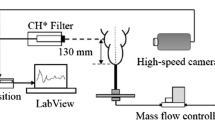Abstract
Large scale dynamic behavior of buoyant diffusion flames were studied experimentally. It was found that buoyant diffusion flames originating from circular nozzles exhibit two different modes of flame instabilities. The first mode results in a sinuous meandering of the diffusion flame, characteristic of flames originating from small diameter nozzles. This instability originates at some distance downstream of the nozzle exit in the contraction region of the buoyant flame envelope and develops into a sinuous motion of the flame. The second mode is the varicose mode which develops very close to the nozzle exit as axisymmetric perturbations of a contracting flame surface. In this mode, flame oscillations result in the formation of toroidal vortical structures that convect through the flame and cause periodic burn out at the flame top resulting in the observed flame height fluctuations. The average flame heights are found to be typically shorter for these flames. The oscillation frequencies and their scaling for the two modes are also different with the sinuous mode having higher frequencies than the varicose mode. It was also observed that the instability can switch from one mode to the other and the probability of observing the varicose mode appears to increase with increasing Richardson number. Additionally, the feasibility of altering the behavior of buoyant diffusion flames was explored through variation of the oxidizer medium density. It was found that the flame oscillations can be completely suppressed for flames burning in helium rich helium–oxygen mixtures. At lower helium concentrations, the oscillation frequency can be significantly reduced. In order to enhance the buoyancy effect, CO2–O2 mixtures were also studied. However, the density increase and its effects on flame oscillation frequency were found to be small compared to those flames burning in air. These experiments point towards the feasibility of altering buoyant flame behavior under earth gravity and studying the large scale dynamical aspects of buoyant flames without the need of variable gravity environment.
Similar content being viewed by others
Author information
Authors and Affiliations
Additional information
Received: 2 March 1999/Accepted: 6 August 1999
Rights and permissions
About this article
Cite this article
Cetegen, B., Dong, Y. Experiments on the instability modes of buoyant diffusion flames and effects of ambient atmosphere on the instabilities. Experiments in Fluids 28, 546–558 (2000). https://doi.org/10.1007/s003480050415
Issue Date:
DOI: https://doi.org/10.1007/s003480050415




